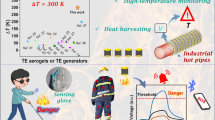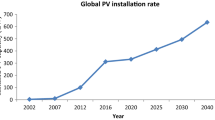Abstract
A novel Hybrid Thermal Protection System (Hybrid TPS) for space probes entering planetary atmospheres at very high velocities has been designed and tested. The system mainly consists of a coarsely porous MgO/spinel refractory made by SHS and filled with a reinforced phenolic material creating a hybrid system. The two main constituents act synergistically protecting each other from the extreme heating developed during atmospheric entry and reduce the recession and irregularity at the front surface. The results of the investigation have shown that the hybrid system offers satisfactory protection at heat fluxes of more than 2000 kW/m2 and total heat loads of more than 200 MJ/m2 and is thus a promising material for high-speed atmospheric entry usages.
Similar content being viewed by others
References
Laub, B. and Venkatapathy, E., Thermal Protection System Technology and Facility Needs for Demanding Future Planetary Missions, in Int. Workshop on Planetary Probe Atmospheric Entry and Descent Trajectory Analysis and Science, Portugal, Lisbon, October 6–9, 2003.
Vekinis G., Hybrid Thermomechanical Protection System for Spacecraft and Space Probes, Greek Patent 1006416, 2007.
Xanthopoulou, G. and Vekinis, G., MgO/MgAl2O4 Refractories by SHS, Int. J. SHS, 2002, vol. 11, no.1, pp. 117–129.
Cambridge Materials Selector, UK: Cambridge University, 2001.
Xanthopoulou, G. and Vekinis G., An Overview of Some Environmental Applications of Self-Propagating High-Temperature Synthesis, Adv. Environ. Sci., 2001, vol. 5, no. 2, pp. 117–128.
Hutchings, I.M., Tribology: Friction and Wear of Engineering Materials, London: Edward Arnold, 1992.
Gladoun, G., Baymouhamedov, E., and Sherinkhanov, A., SHS of High-Temperature Light Refractories, J. Eng. Phys. Thermophys., 1993, vol. 65, no. 4, pp. 1024–1025.
Xanthopoulou, G.G. and Vekinis, G., Hybrid Thermal Protection System for Spacecraft Based on MgO SHS Refractories, Book of Abstracts, in X Int. Symp. on SHS Tsakhkadzor, Armenia, Jule 6–11, 2009, pp. 152–153.
Vekinis, G. and Xanthopoulou, G., A Hybrid Ceramic—Polymer Composite TPS for Multiple Atmospheric Entry Probes, in Proc. III Int. Planetary Probe Workshop, Anavyssos, Attiki, Greece, June 27–Jule 1, 2005.
Vekinis, G. and Xanthopoulou, G., Hybrid TPS: Current Developments and Prospects, in Proc. V Int. Planetary Probe Workshop, Bordeaux, France, June 25–29, 2007, p. 139.
Xanthopoulou, G., Self-Propagating High-Temperature Synthesis of Novel High-Temperature Refractory Materials, Greek Patent 1004679, 2004.
Gladoun-Xanthopoulou, G. and Dzhamanbekoba, O., SHS Batch for Preparation of High-Temperature Porous Refractory Materials, USSR Inventor’s Certificate 1730813, 1992.
Author information
Authors and Affiliations
Corresponding author
Additional information
The text was submitted by the authors in English.
About this article
Cite this article
Vekinis, G., Xanthopoulou, G. Hybrid TPS: A novel hybrid thermal protection system for atmospheric entry space probes based on SHS-Produced MgO/spinel refractories. Int. J Self-Propag. High-Temp. Synth. 19, 258–275 (2010). https://doi.org/10.3103/S1061386210040059
Received:
Published:
Issue Date:
DOI: https://doi.org/10.3103/S1061386210040059




